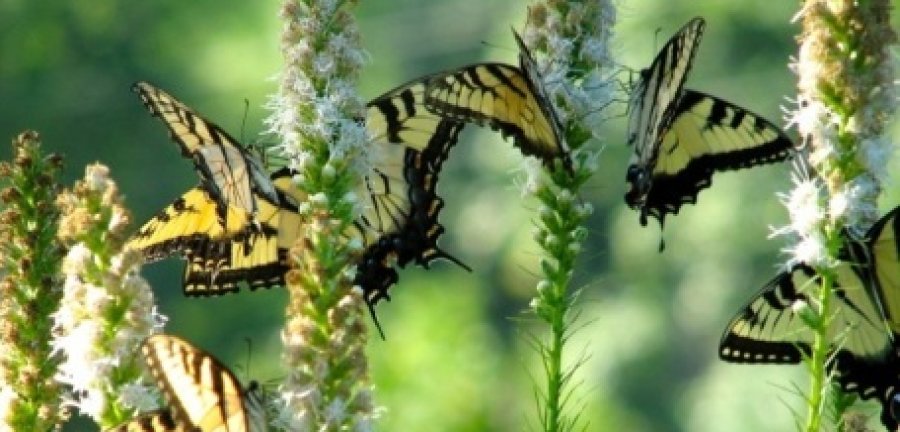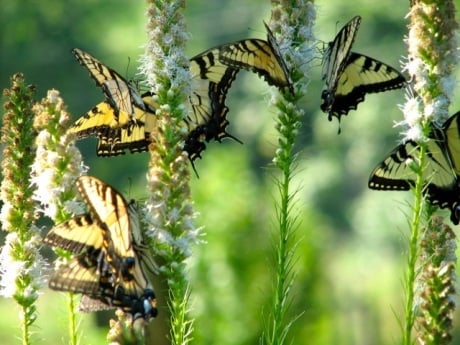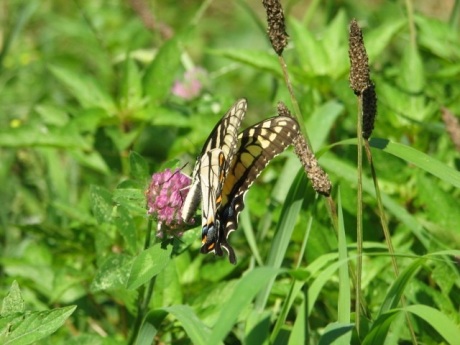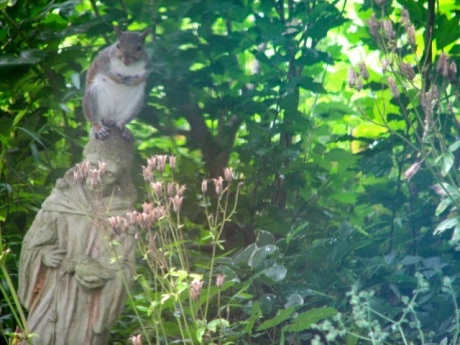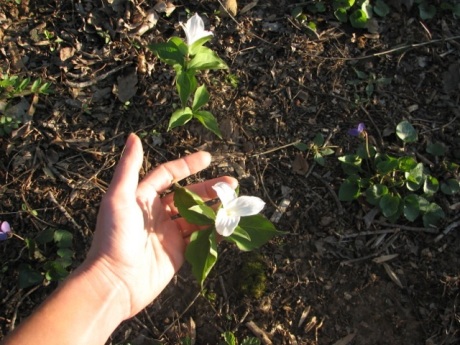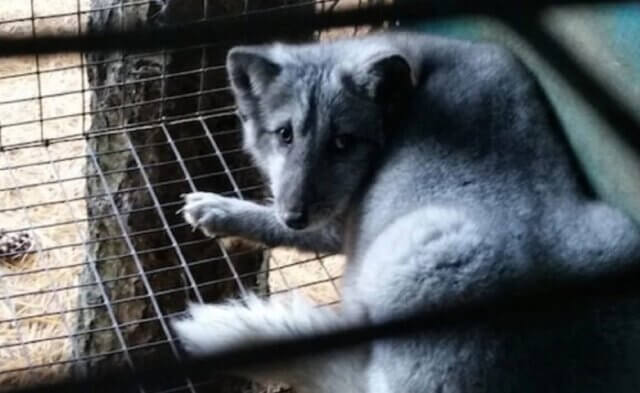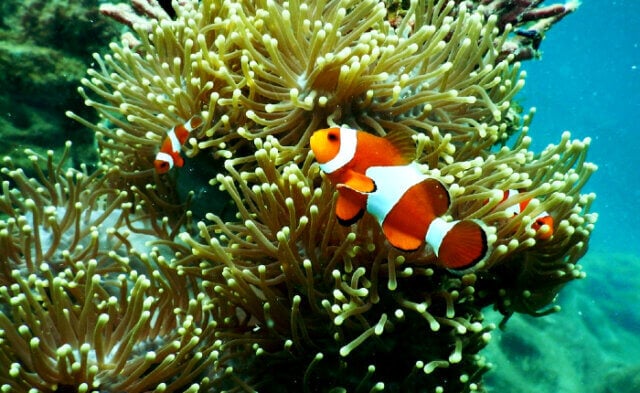Without native plants, wildlife cannot be sustained. In an overly simplified nutshell, the lovely cultivars that originate from Asia and Europe and can be purchased at your local nursery or big box store to beautify your landscape are not palatable to our little insect friends. “So what?” you might ask, as you scratch your head.
Well, take the iconic and increasingly harder-to-spot monarch butterfly, which most of us still recognize and love. Why are monarchs disappearing? Because the only food that monarch caterpillars can eat in order to survive are plants in the milkweed family. So although adult monarchs aren’t too fussy about where they obtain their pollen, the only food that is palatable for their babies is milkweed. Adult monarchs need these plants on which to lay their eggs because if their caterpillars have nothing that they can eat, they will, of course, starve and not grow to be adults to continue the cycle.
This is a beautiful plant called Blazing Star (Liatris). Took me a long time to get this snapshot–did you know butterflies are very camera shy? Don’t know why it is when you point a camera they flutter away. So I laid in the grass for a while until they came back.
Adding to this conundrum is the fact that huge farming operations—in particular, the corn belt of the Midwestern United States—have wiped out the tall meadows in which the milkweed grew that sheltered and sustained the monarchs on their migration to Mexico. These corridors have now been replaced with Roundup Ready crops.
Grow clover instead of lawn grass; clover requires no mowing and bees and butterflies love it.
The problem of finding palatable food applies to all our native insects who have evolved with our native birds. The insects need particular plants to sustain themselves. If the plants they can eat are less plentiful or are no longer present, the baby birds will also have less or even not enough to eat. That means fewer adult birds. The same goes for other small animals and reptiles.
Here are some seed heads from blue columbines, a hummingbird favorite. St. Francis’ head is a squirrel favorite. I got busy pulling out the vinca, the variegated leaves in the middle of the picture near the bottom.
Adult birds now have to work enormously hard to find food that is adequate for their babies. Here’s a discouraging statistic: Over the last 50 years, our native bird populations have declined by 40 percent. Some statistics are even worse, depending on the species and the area that the birds inhabit.
I have a wise friend who told me that if she introduces a plant into her garden and something isn’t eating it, the plant doesn’t get to stay. I live by those words, too. In fact, I do not care much for a perfectly manicured and lifeless lawn, flanked by Asian plantings with enormous flowers that mostly seem to baffle the local insects.
Does this mean that you should go and rip out all the plants in your yard that aren’t native to your region?
Well, yes and no. The home in Virginia I moved to came with a garden. In the garden, I have a huge variety of trees, shrubs, and flowers. The yard came with some native plantings, which is great, and I’ve been slowly but surely adding more.
Some of the flowers I inherited are not native at all. The rose campions that grow here originate from Eastern Europe. I keep them because they bloom early and I get to watch the bees, hummingbirds, and butterflies enjoy their nectar. The deer who come to my yard ignore them. The rose campions drop their seeds politely and share the space nicely with the other flowers I have put there. In other words, they play nicely with their friends instead of running them out of town.
This bee face planted in the flower at the end of the day after everyone left and fell asleep.
Why is this important? The problem with a lot of non-native “exotic” plants is that when you bring the little blighters home and plant them in your garden, they’re apt to escape and take over entire ecosystems. If you don’t believe this can happen, I wish you could come and take a look at my woods. What you’d be able to see is that the woods are inundated with Japanese barberry shrubs. While they’re very decorative and lovely, they also have red berries that the birds like to eat and deposit everywhere. In our second year at this home, my husband helped me rip out six huge mature plants from my yard using a truck and a rope, but my woods are unfortunately already infested with them.
There are no natural mechanisms here to keep the barberry in check, and the birds distribute it everywhere. It grows while you look at it. This is now a problem for our slow-growing native white oaks that cannot compete against this thug. That is a shame, because the barberries that have taken over my woods—along with the autumn olives and privets, which were imported by nurseries and sold here—don’t serve any purpose whatsoever. They sustain nothing and threaten the existence of the beautiful white oaks that do sustain about 200 different species of wildlife—that is, if they can grow under these stressful conditions.
Take our beautiful little woodland flowers. A trillium takes two years to germinate from the time the seed is planted. The same is true for our native bloodroot. We are seeing these lovely flowers disappear because they’re being overrun by invasive species that were brought here and are still being sold by nurseries.
Here are my trilliums.
So are you ready to give our lovely native plants a hand and help out the smallest creatures that keep our world turning happily? On the East Coast, I am prepared!
Using a system called winter sowing, I have started many seeds to add to my growing collection of wildflowers. I am hoping the following will germinate and grow for me: Joe Pye weed, bloodroot, mayapples, wild four-o’clocks, Jacob’s ladder, jack-in-the-pulpit, native columbines, camassia, New England asters—the list goes on! Naturally, I am starting several types of milkweed, including Asclepias tuberosa, aka “butterfly weed.” I hope gardeners in the Midwest will do their part to help out our migrating monarch butterflies as they head to Mexico, because no matter what we do on our end to give them a good start, they’ll still have a long way to go and need all the help that they can get.
When it comes to starting plants, I admit I do get carried away! Really, the best advice that was given to me is this: Start small, and build on your success. And if a small “hell strip” in front of your house is the only area that you have for a small garden, do the planet a favor and plant some bug food in it! If you do, the insects will come.
Written By Jasmin Ponti
PETA member Jasmin Ponti became an accidental gardener after inheriting an overgrown yard full of plants that she couldn’t identify and didn’t know what to do with. She became a Master Gardener and was fortunate enough to meet some wonderful ladies who introduced her to the concept of using more natives in the landscape.
Jasmin also learned that everybody thinks his or her way is the only way to garden! For Jasmin, that means providing food and habitat for animals. It keeps them happy, and she gets to see the beautiful show.

